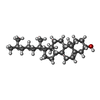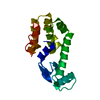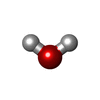+Search query
-Structure paper
| Title | Molecular mechanism of pH sensing and activation in GPR4 reveals proton-mediated GPCR signaling. |
|---|---|
| Journal, issue, pages | Cell Discov, Vol. 11, Issue 1, Page 59, Year 2025 |
| Publish date | Jun 25, 2025 |
 Authors Authors | Chongzhao You / Shimeng Guo / Tianwei Zhang / Xinheng He / Tianyu Gao / Wenwen Xin / Zining Zhu / Yujie Lu / Youwei Xu / Zhen Li / Yumu Zhang / Xi Cheng / Yi Jiang / Xin Xie / H Eric Xu /  |
| PubMed Abstract | Maintaining pH homeostasis is critical for cellular function across all living organisms. Proton-sensing G protein-coupled receptors (GPCRs), particularly GPR4, play a pivotal role in cellular ...Maintaining pH homeostasis is critical for cellular function across all living organisms. Proton-sensing G protein-coupled receptors (GPCRs), particularly GPR4, play a pivotal role in cellular responses to pH changes. Yet, the molecular mechanisms underlying their proton sensing and activation remain incompletely understood. Here we present high-resolution cryo-electron microscopy structures of GPR4 in complex with G proteins under physiological and acidic pH conditions. Our structures reveal an intricate proton-sensing mechanism driven by a sophisticated histidine network in the receptor's extracellular domain. Upon protonation of key histidines under acidic conditions, a remarkable conformational cascade is initiated, propagating from the extracellular region to the intracellular G protein-coupling interface. This dynamic process involves precise transmembrane helix rearrangements and conformational shifts of conserved motifs, mediated by strategically positioned water molecules. Notably, we discovered a bound bioactive lipid, lysophosphatidylcholine, which has positive allosteric effects on GPR4 activation. These findings provide a comprehensive framework for understanding proton sensing in GPCRs and the interplay between pH sensing and lipid regulation, offering insights into cellular pH homeostasis and potential therapies for pH-related disorders. |
 External links External links |  Cell Discov / Cell Discov /  PubMed:40555728 / PubMed:40555728 /  PubMed Central PubMed Central |
| Methods | EM (single particle) |
| Resolution | 2.36 - 2.59 Å |
| Structure data | EMDB-61370, PDB-9jco: EMDB-61371, PDB-9jcp: EMDB-61372, PDB-9jcq: |
| Chemicals |  ChemComp-CLR:  PDB-1l35:  ChemComp-HOH: |
| Source |
|
 Keywords Keywords | SIGNALING PROTEIN / Cryo-EM / GPCR / proton-sensing / GPR4 / pH 6.5 / Gs / complex / pH 7.4 / Gq |
 Movie
Movie Controller
Controller Structure viewers
Structure viewers About Yorodumi Papers
About Yorodumi Papers









 homo sapiens (human)
homo sapiens (human)
